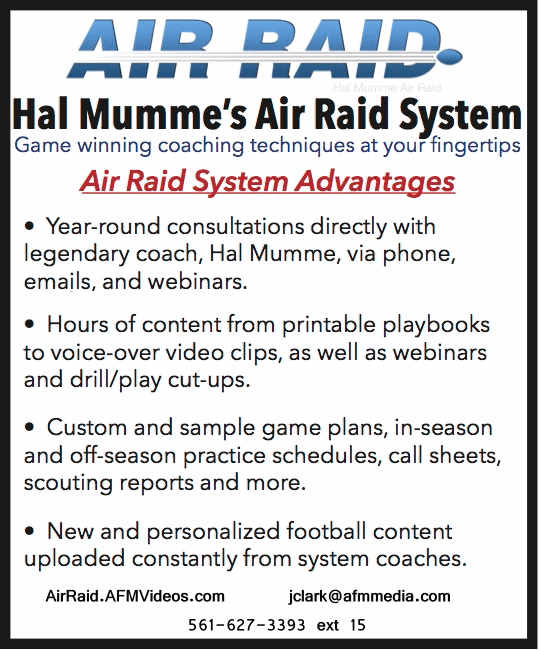Defining, Evaluating, and Developing the Non-Physical Elements of QB Play – Part II
By Eric Marty, Head Football Coach
Reedley College
Continued from Monday, June 5th…
2. The ability to see accurately, completely, and without distraction from the pocket.
First, you have the ability to ‘see’. It involves the willingness and eye discipline to actually see from the confines of the pocket despite at times having sight obscured by the screen of bodies and distractions in close proximity. It takes courage and determination to ignore the pass rush and keep staring down field to see what must be seen. Quarterbacks regardless of height need to learn to slide and move in the pocket to open up sight lines when linemen do obscure their vision so they can indeed see what they need to see.
‘Vision’ is much more innate. Some athletes are blessed with great vision. They naturally see the field, the spacing of players, and what is a jumble of 21 bodies to other athletes is organized chaos to them. As a result, they are able to anticipate open receivers and throwing lanes. Conversely, some quarterbacks do not have that same innate ability.
Evaluating it: Is our quarterback seeing what he needs to see?
- The number one indicator – is the ball being held too long? When one or two in the progression is open, does the ball get out immediately? Or do eyes come down to the rush, and a scramble drill ensues?
- When we ask our quarterback, “What did you see?” Can he answer correctly?
- Regardless of a completion or incompletion – did he gain sight of his read? If he can tell us what the defender did, we are ok. If he says I do not know, or I could not see him, he is not doing the job.
 Developing it: While it is hard to develop vision, we can develop our quarterbacks’ ability to see.
Developing it: While it is hard to develop vision, we can develop our quarterbacks’ ability to see.
- Individual drills play a large part. We like ‘forced reset’ drills, wave drills, avoid drills, anything where the quarterback is forced to slide off his spot, and reset back on balance while keeping his eyes down field.
- Then we take those same drills and try to make them more functional. We will incorporate forced slides and resets while throwing routes on air, 1 on 1’s and even 7 on 7.
- Another way to get a quarterback simulated pocket reps is throwing 7 on 7 with an offensive line pass setting in front of him. Or if the offensive line isn’t available we will have injured players, or even our next 7 on 7 group line up around the snapper, anything to put a screen of bodies in front of our quarterback so they can practice peering downfield through visual interference to gain sight of his reads.
- Finally, guys need team repetitions. Quarterbacks can throw all summer, and do as much individual and 7 on 7 as possible, but there is no substitute for real reps from a live pocket.
3. The ability to get the football into the hands of other skill players by working through pass progressions quickly, decisively, and correctly.
I firmly believe there are many quarterbacks at every level who can get through a two progressions read. But the special ones are guys that can get through three and even four progressions when necessary to get the ball out of their hand before the pass rush hits home.
Evaluating it: Is the ball coming out to the correct receiver, as quickly as possible?
- Is our quarterback getting the ball to one in the progression as soon as possible? And if one is covered is he able to get to two and even three before the pocket breaks down?
- If two players in the progression are open, does the ball go to the proper receiver?
- When we are being blitzed, does he get the ball get out immediately to his hot or quickest throw?
- Is our quarterback guessing or is he actually reading the play out?
- Is our quarterback effectively applying pre-snap information to expedite his progressions?
Developing it:
- We will use progression style drills in individual periods where we ask the quarterback to set to one, then two, then finally throw the ball to three.
- During routes on air, we try to make the quarterback go through his progression and land on whatever route he is throwing.
- Say we are throwing corner routes to the slot receivers. We read smash hitch to corner, so our quarterback sets to throw the hitch then resets and delivers the ball to the corner route.
Check down 7 on 7. Our quarterback must throw his last progression (or check down). Then after each rep he has to come back and tell us where the ball could and should have gone (Example: he checked it down to three but his first read was open). This gives a quarterback a feel for the rhythm and decision making it takes to get through a three read progression.
I believe much of any quarterback’s successes and failures on the field can be attributed to the aforementioned elements 1-3 regardless of their physical ability. Consequently, the extra effort in trying to develop a quarterback’s non-physical skill set can pay dividends in the short term for your team, and in the long run for that player’s career.

